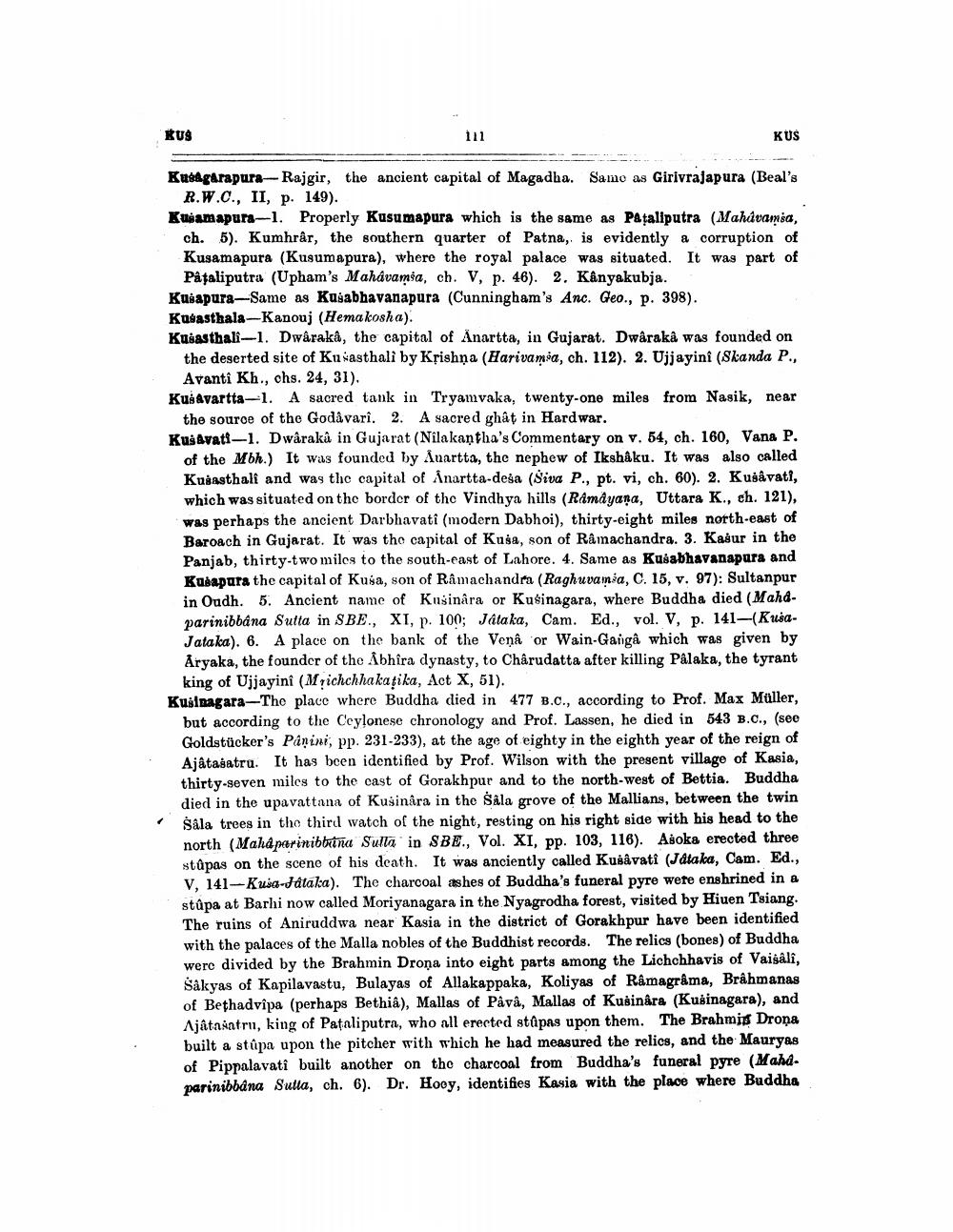________________
KUS
111
KUS
Kusagarapura--- Rajgir, the ancient capital of Magadha. Samo as Girivrajapura (Beal's
R.W.C., II, p. 149). Kusamapura-1. Properly Kusumapura which is the same as Pataliputra (Mahavamsa,
ch. 5). Kumhrâr, the southern quarter of Patna, is evidently a corruption of Kusamapura (Kusumapura), where the royal palace was situated. It was part of
Påtaliputra (Upham's Mahavamia, ch. V, p. 46). 2. Kanyakubja. Kusapura-Same as Kusabhavanapura (Cunningham's Anc. Geo., p. 398). Kugasthala-Kanouj (Hemakosha). Kusasthali-1. Dwaraka, the capital of Anartta, in Gujarat. Dwaraka was founded on
the deserted site of Kuwasthali by Krishna (Harivamia, ch. 112). 2. Ujjayini (Skanda P.,
Avanti Kh., chs. 24, 31). Kusavartta-1. A sacred tank in Tryamvaka, twenty-one miles from Nasik, near
the source of the Godåvari2. A sacred ghat in Hardwar. Kusavati-1. Dwaraka in Gujarat (Nilakantha's Commentary on v. 54, ch. 160. Vana P.
of the Mbh.) It was founded by Auartta, the nephew of Ikshâku. It was also called Kugasthali and was the capital of Anartta-desa (Siva P., pt. vi, ch. 60). 2. Kušavati, which was situated on the border of the Vindhya hills (Ramdyana, Uttara K., eh. 121), was perhaps the ancient Darbhavatî (modern Dabhoi), thirty-eight miles north-east of Baroach in Gujarat. It was the capital of Kusa, son of Ramachandra. 3. Kasur in the Panjab, thirty-two miles to the south-east of Lahore. 4. Same as Kusabhavanapura and Kusapura the capital of Kusa, son of Ramachandra (Raghuvania, C. 15, v. 97): Sultanpur in Oudh. 5. Ancient name of Kusinâra or Kusinagara, where Buddha died (Mahdparinibbana Sutta in SBE, XI, p. 100; Jataka, Cam. Ed., vol. V, p. 141-(KusaJataka). 6. A place on the bank of the Venâ or Wain-Gangå which was given by Aryaka, the founder of the Abhîra dynasty, to Chârudatta after killing Pålaka, the tyrant
king of Ujjayini (Michchhakatika, Act X, 51). Kusinagara - The place where Buddha died in 477 B.C., according to Prof. Max Müller,
but according to the Ceylonese chronology and Prof. Lassen, he died in 543 B.C., (see Goldstücker's Panini, pp. 231-233), at the age of eighty in the eighth year of the reign of Ajậtasatru. It has been identified by Prof. Wilson with the present village of Kasia, thirty-seven miles to the cast of Gorakhpur and to the north-west of Bettia. Buddha died in the upavattana of Kusinara in the Sala grove of the Mallians, between the twin šala trees in the third watch of the night, resting on his right side with his head to the north (Mahd parinibbutna Sulla in SBE., Vol. XI, pp. 103, 116). Asoka erected three stūpas on the scene of his death. It was anciently called Kusâvati (Jataka, Cam. Ed., V, 141-Kusa-Jataka). The charcoal ashes of Buddha's funeral pyre wete enshrined in a stúpa at Barhi now called Moriyanagara in the Nyagrodha forest, visited by Hiuen Tsiang. The ruins of Aniruddwa near Kasia in the district of Gorakhpur have been identified with the palaces of the Malla nobles of the Buddhist records. The relics (bones) of Buddha were divided by the Brahmin Drona into eight parts among the Lichchhavis of Vaigali, Säkyas of Kapilavastu, Bulayas of Allakappaka, Koliyas of Râmagrâma, Brahmanas of Bethadvipa (perhaps Bethiâ), Mallas of Påvå, Mallas of Kusinara (Kusinagara), and Ajâtaintru, king of Pataliputra, who all erected stupas upon them. The Brahmis Drona built a stúpa upon the pitcher with which he had measured the relics, and the Mauryas of Pippalavati built another on the charcoal from Buddha's funeral pyre (Mahd. parinibbana Sutla, ch. 6). Dr. Hooy, identifies Kasia with the place where Buddha




